The Complete Guide to Indoor Skydiving
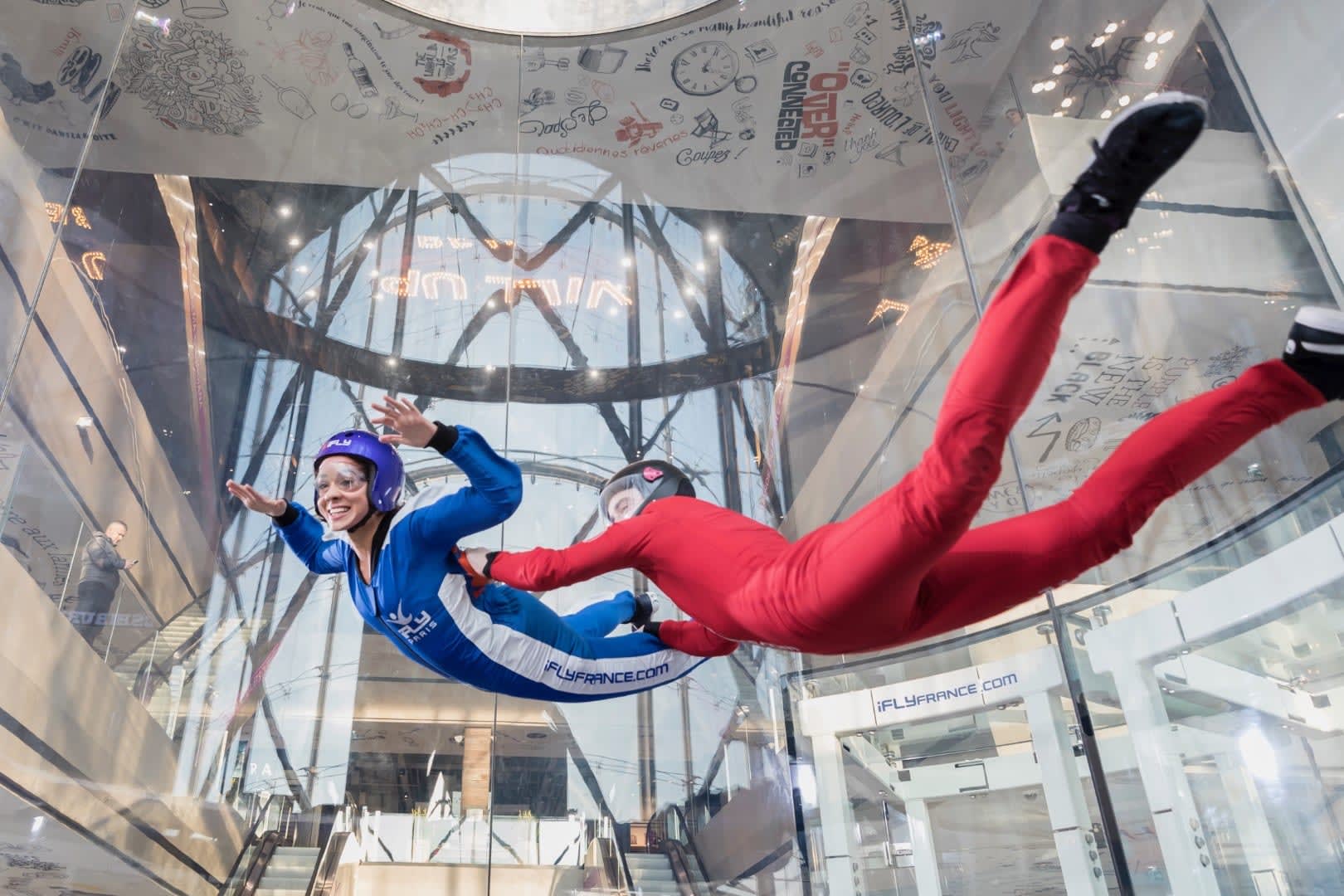
Indoor skydiving is an indoor experience like no other. This flying sensation is an incredible experience that is even better shared, with your loved one, family, or friends.
With an ever-increasing number of indoor skydiving centres in major cities across the globe, there’s a growing amount of opportunities to try this thrilling indoor aerial adventure near where you are.
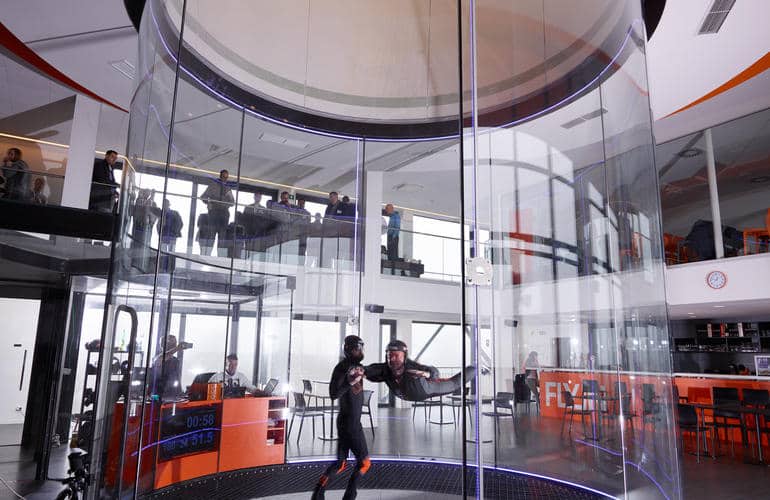
What is Indoor Skydiving?
Indoor skydiving offers a simulation of the experience of a skydiving free fall. Happening in vertical wind tunnels, it is a much cheaper alternative to an actual parachute jump, additionally offering the opportunity for a longer experience freefall sensation.
Unlike the real thing, indoor skydiving takes place in a controlled environment and is a simulation that is more accessible to everyone than actually jumping from a plane. Indeed, it is neither physically nor psychologically demanding and is also great fun for those who suffer from fear of heights or flying in small planes.
Beginner flights only allow you to fly around a metre above from the bottom of the wind tunnel, thus they don’t create any sense of height or falling, and don’t involve much movement so no feelings of sickness or dizziness are created either.
What is a wind tunnel?
Indoor skydiving is practiced within a vertical wind tunnel – a large vertical and cylindrical plexiglas tunnel in which an upwards moving column of air creates enough lift for flying.
Wind tunnels have been used since the early 19th century. A wind tunnel was even used to study wing shapes by the Wright brothers before they completed the first flight in history in 1903. Yet it wasn’t until the 60’s that the US Army realized that vertical wind tunnels could simulate freefalling conditions for paratroopers. And in 1982, the first two sport wind tunnels were opened for everyone to enjoy.
Wind tunnel technology is very simple. Giant fans, located below or above the tunnel, blow large quantities of air into a closed circuit. When the air passes through the (thinner) plexiglas tunnel, it is accelerated by a large-scale Venturi effect, to reach speeds between 80 and 185mph, enough to lift a human body by simple body drag.
So yes, essentially a wind tunnel is just a giant fan! But don’t worry, the flight zone is protected by two metal nets at the top and bottom, so you won’t get chopped up by these 450kW each monster fans. Additionnaly, wind speed is constantly monitored and controlled by an instructor watching each individual flight. Thus, air speed in the tunnel can be increased or decreased at will depending on the flier’s ability as well as body drag created.

What will I do for my first indoor flight?
Pre-flight
After arriving the recommended one hour before your flight time and signing the necessary waiver documentation, your indoor skydiving experience will then begin with a short pre-flight safety training and briefing with a flight instructor in a room separate to the wind tunnel.
During this briefing, the indoor skydiving instructor, who may also be the instructor that joins you in the wind tunnel, will talk you through the sensations that you might feel when flying. He will also introduce the hand signals that they may give you whilst in the wind tunnel, as wind speed makes talking impossible in the tunnel.
These hand signals are used to signify to the flier whether they need to straighten or bend their legs or arms, and if they need to relax their body. The instructor will also give you a demonstration of the general position that you should adopt when in the air.
Next you will get suited up, in a full-body flight suit for maximum safety and optimal body drag. Flight suits also have fabric handles stitched to shoulders and legs, for the instructor to hold and guide you on your first flight. You will also be given goggles, ear plugs and a helmet to wear.
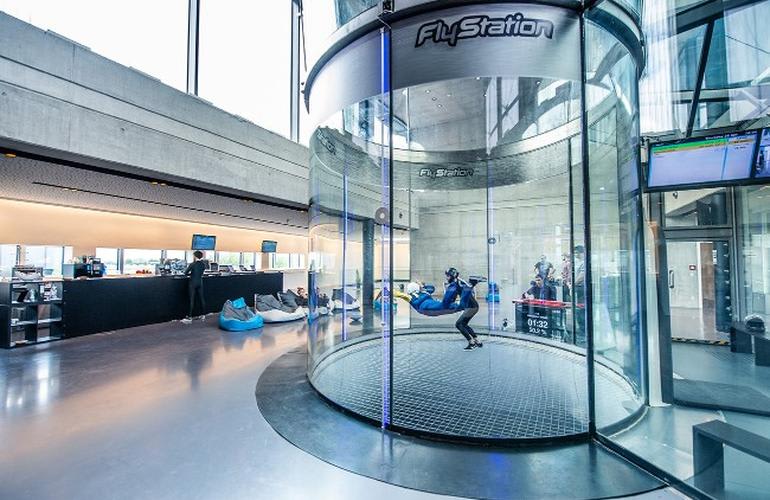
During the flight
After a short wait, it will be your turn in the wind tunnel. You will enter via a small opening, presenting yourself at the entrance of the tunnel with your arms above your head, palms flat, and elbows partially bent. Your indoor skydiving instructor will nod for you to gently lean forward, and will help you lay flat on your front on the air flow, stably and in the correct position.
First time flights usually last 1 minute to 2.5 minutes long. This may seem very short, but do not forget that the length of the free-fall during a skydive from 14,000ft is usually less than a minute long. So you will fly for longer whilst indoor skydiving, than when going off from a plane. When in the wind tunnel, you will feel weightless and time will seem to slow down, as you enjoy every second of it!
If you have opted for a second flight, you will exit the tunnel and wait a few minutes for other flies to take their turn before returning to the tunnel. Often your indoor skydiving instructor will then briefly tell you how to adapt your flying position for your second session.
It is usually a great idea to opt in for a 2-flights package. Indeed, your brain and muscle memory will absorb and digets the sensation of your first flight during the 5-10 pause between flights. This in turn enable for (usually) an even better second flight, with more control and enjoyment.
Last but not least, if you have opted in for the “helicopter” option, at some point during the flight, your instructor will grab the handles on your flysuit and bring you in a controlled rotation up to 10m above the bottom net. An incredible experience we highly recommend !
Post-flight –
After your flight, you will have a short debrief, the opportunity to do another ‘jump’ (if there is time in the wind tunnel’s schedule) and will de-suit and possibly be presented with the option to buy a photo or video reminder of your experience!

Who can do Indoor Skydiving?
Indoor skydiving is a highly inclusive and accessible sport, able to be tried by people with reduced mobility, amputees or fliers with partial paralysis. It is also accessible for deaf or hearing impaired visitors and blind or visually impaired visitors.
This sport is known for its accessibility – if you have any doubts about whether yourself or one of your party can fly, it is highly recommended to speak to the staff at the wind tunnel that you intend to visit beforehand. A majority of wind tunnels are happy and easily able to offer a tailored experience and many have a specially trained instructor, and require only minimal preparation for you to take part.
There are still, however, a number of other restrictions on who can head to the wind tunnel and fly…
Minimum Age:
This condition is specific to each of the wind tunnels and if under the age of 18 the flier will need to have a parent or guardian present on the day and at the training briefing and written authorization for their participation.
Younger children are often permitted to fly too, and it can be an exciting experience, but the minimum age varies at each individual wind tunnel. On average, indoor skydiving centres allow flying from 5 yrs old.

Maximum Weight:
This again varies, though is usually around 110-120kg.
Injuries:
Unfortunately you are not allowed to fly if you have recently dislocated your shoulder or knee nor if you are currently wearing a cast nor have any broken limbs.
If you have had a shoulder injury in the past this could still be affected in the wind tunnel, as the air is propelled at very high speeds. It is advisable to speak to your doctor before trying this sport as well as with the staff of the wind tunnel that you will be visiting. Those with neck, back or heart problems should also consult with their doctor before trying indoor skydiving.
Pregnant women:
Indoor skydiving unfortunately is not recommended for women who are pregnant.
It is also worth noting that visitors under the influence of drugs or alcohol will not be permitted to indoor skydive, as this sport requires you to be fully engaged and attentive to what your instructors are telling you to do.
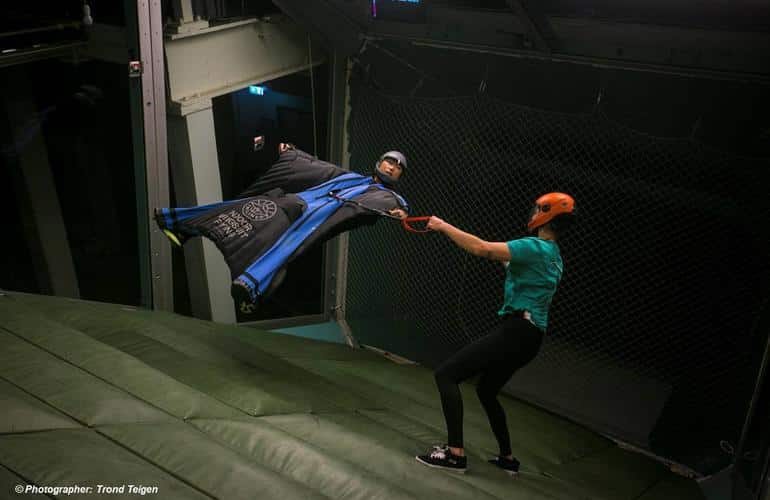
Variations of the sport
Indoor skydiving itself can be tried with different additions, for instance many wind tunnels offer virtual reality experiences where fliers wear a VR headset and experience their free fall in the wind tunnel with visuals of an outdoor free fall, in different locations.
Another variation of this indoor sport is indoor wing suit flying, where the flier wears a wing suit rather than the jumpsuit worn in indoor skydiving and flies in a tilted horizontal wind tunnel rather than a vertical one.
Outdoor skydive: The original, authentic experience which the indoor wind tunnel seeks to recreate – though also offering an amazing experience on its own, is a less accessible and more expensive alternative. Outdoor skydives however are known and beloved for the incredible panoramic views they offer and the incomparable adrenaline rush that the skydiver feels.
Indoor wind tunnel free fall is a real sport, with competitions held annually such as the FAI World Indoor Skydiving Championship, the FAI European Indoor Skydiving Championship, the FAI World Cup of Indoor Skydiving and the Wind Games. More information can be found at www.fai.org.
Indoor wind tunnels are of course used to practice indoor skydiving as a sport in its own right, but are often also used by professional skydivers to practice their aerobatic routines or their posture and positions that they will adopt or perform when undertaking a real jump from a plane.
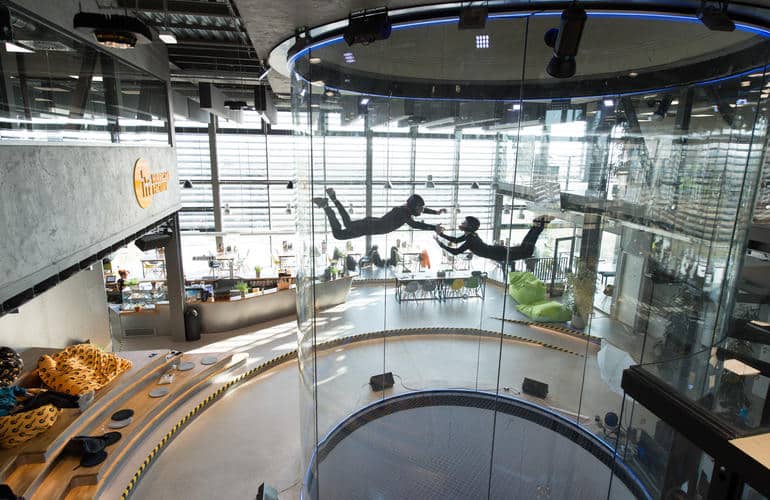
Locations for Indoor Skydiving
Now found in many large cities in Europe, North America, Oceania and increasingly across the globe – head to locations in capital cities such as Paris, Berlin, Madrid and Stockholm for adventures in wind tunnels in Europe, or to Chicago, Seattle, San Diego and a multitude of other states in the USA, or to Bali, Singapore, New Zealand, Brazil… there is a whole world of indoor skydiving adventures waiting to be had!
More information about indoor skydiving and related activities:
- Find all the destinations to practice Indoor Skydiving
- More information on indoor wingsuit flying
- All our articles about Skydiving in general